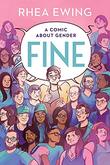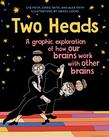Though I appreciate the artistry of the form, I’ve never been a comic-book guy. However, since my early days at Kirkus, I have come to love full-length graphic nonfiction, whether memoir, biography, history, science, or popular culture. (I’m a big fan of graphic novels, as well, but that’s a topic for another day.) From Maus to Fun Home to Asterios Polyp, there’s something truly special about the perfect mix of text and illustration. Indeed, the first Kirkus Prize for Nonfiction went to Roz Chast’s Can’t We Talk About Something More Pleasant? and Kristen Radtke’s Seek You was a finalist for last year’s prize.
For whatever reason, in the past few years I haven’t seen as many works of graphic nonfiction, so I try to highlight the extraordinary books when I can. This April, I have two recommendations, both of which received starred reviews.
 First up is Rhea Ewing’s Fine: A Comic About Gender (Liveright/Norton, April 5), which our review calls “a timely, educative, and vividly rendered illustrated portrait” of gender identity. In addition to their own story, Ewing interweaves the experiences of 50 other individuals varying in age, race, and gender. The book is both intimate and wide-ranging, as Ewing “ably explores the complexities and difficulties of expressing gender in terms of sexuality, health care, visibility, language, and bathroom choices, and the elegant graphic format affords the author ample room to develop their themes visually.” The author is a compassionate and informative guide to issues that continue to be misunderstood or ignored, creating a “vital, richly textured resource for anyone seeking a better understanding of gender identity.”
First up is Rhea Ewing’s Fine: A Comic About Gender (Liveright/Norton, April 5), which our review calls “a timely, educative, and vividly rendered illustrated portrait” of gender identity. In addition to their own story, Ewing interweaves the experiences of 50 other individuals varying in age, race, and gender. The book is both intimate and wide-ranging, as Ewing “ably explores the complexities and difficulties of expressing gender in terms of sexuality, health care, visibility, language, and bathroom choices, and the elegant graphic format affords the author ample room to develop their themes visually.” The author is a compassionate and informative guide to issues that continue to be misunderstood or ignored, creating a “vital, richly textured resource for anyone seeking a better understanding of gender identity.”
Just as informative and enlightening is Two Heads: A Graphic Exploration of How Our Brain Works With Other Brains (Scribner, April 26), written by neuroscientists Uta and Chris Frith and their son, children’s book author Alex Frith. Illustrated by Daniel Locke, the book leads readers on an “inspirational scientific voyage that highlights the importance of collaboration,” according to our reviewer. While most popular science books about the brain focus on the mechanics of a single brain, Two Heads shows us that “brains function differently and better in connection with other brains and that collaborations with others usually produce superior results compared to results achieved when working alone. Furthermore, the more diverse the collaborative teams, the better.”
 The Friths are unquestionably well qualified to explain the endlessly complex systems involved in neuroscience and social connection; anyone doubting the gravity of their work can Google their impressive credentials and consult the 15 pages of notes at the end of the book. As the authors note, “it might not look like one, but this is intended to be a proper academic work. All the studies described are real, and all the findings described have been published in various papers, journals, and books. We don’t think any are from graphic novels, sadly.” Expressive, colorful, and precise, Locke’s illustrations “clarify challenging issues involving, among other topics, autism and schizophrenia; in-groups and out-groups; how the brain can function like a hive of bees; and the deleterious effects of the failure to connect.” If you’re seeking a thorough and accessible introduction to your brain, look no further.
The Friths are unquestionably well qualified to explain the endlessly complex systems involved in neuroscience and social connection; anyone doubting the gravity of their work can Google their impressive credentials and consult the 15 pages of notes at the end of the book. As the authors note, “it might not look like one, but this is intended to be a proper academic work. All the studies described are real, and all the findings described have been published in various papers, journals, and books. We don’t think any are from graphic novels, sadly.” Expressive, colorful, and precise, Locke’s illustrations “clarify challenging issues involving, among other topics, autism and schizophrenia; in-groups and out-groups; how the brain can function like a hive of bees; and the deleterious effects of the failure to connect.” If you’re seeking a thorough and accessible introduction to your brain, look no further.
Eric Liebetrau is the nonfiction and managing editor.



































